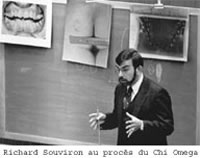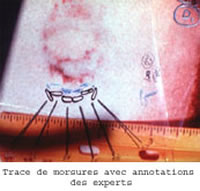Xavier Riaud
Ted Bundy let one’s imagination run wild in America. Firstly, with his profile of the ideal son-in-law, he was the first serial killer who looked as though butter wouldn’t melt in his mouth. Bright, well-educated, he was an ordinary person during the day. At night, that charismatic and handsome man would pretend to be injured or handicaped, would assault, rape and murder young women. Then, he would come back a few hours later to rape the decomposing corpses until putrefaction. He confessed shortly before his execution to 30 homicides committed between 1974 and 1978 but the true total number of his victims could be much higher. He decapitated at least 12 of his victims and kept some of the severed heads in his apartment for a period of time as mementos (http//fr.wikipedia.org, 2012). Anne Rule (1989), his biographer, refered to him as “a sadistic sociopath who took pleasure from another human’s pain and from the control he had over his victims until they died and even afterwards.”
After he had escaped twice, Ted Bundy was arrested in Pensacola, on February 15 1978.
Bundy was suspected in the massacre committed in the Chi Omega sorority house which took place at night on January 14 to January 15 1978. A man with a truncheon entered several bedrooms and murdered two young girls, Lisa Levy and Margaret Bowman. Two other students were also bludgeoned. A little further, another person, Cheryl Thomas was also seriously assaulted but survived (Aynesworth & Michaud, 1989).
On the crime scenes were found numerous marks of blood, sperm, hair and a hood. However, a teeth mark was noticed, reported and photographed on Lisa Levy’s corpse.
To charge the culprit, Bundy’s dental prints and the bite mark were compared. For that matter, his teeth were photographed and a dental casting was carried out. Bundy, who resisted to the casting of his teeth, had to be pinned down by six men.
On June 25 1979 Bundy stood trial in Miami. Since the beginning, the violence of the murders moved the jury members. Photographs of the crime scene were shown to them. They saw the beds, the pile of blood-drenched clothes, Margaret Bowman’s smashed-up head or even the hair spray bottle which was used to sodomize Lisa Levy. Then, the two survivors, Karen Chandler et Kathy Klein, told in front of a dumbfounded court how they had been assaulted and beaten. Cheryl Thomas then warned: “I had five skull fractures and many contusions in my head, a nerve was damaged and I lost the hearing in my left ear as well as my balance. I had a broken jaw and a dislocated shoulder.”
No one of them could say for sure whether Bundy was well and truly the person who had assaulted them. However, another student Nita Neary took an oath and swore having recognized Ted Bundy who was leaving the Chi Omega sorority house on that January night.
After those damning testimonies, it was the forensic odontologists’ turn to bring evidence against the accused’s misdeeds (Porte, 2011 ; Polly, 1994).
Here, the most difficult pieces of evidence to make use of were the teeth marks found on Lisa Levy’s bottom. The proficient forensic odontologists who were called upon, assured that human teeth had their own unique features which unquestionably belonged to a well-determined individual. When a bite is definite and properly measured, a dentist can maintain with almost absolute certainty with a slim error rate whether an individual’s teeth were responsible or not for the studied bite. The error rate resided in the fact that it was impossible to analyse the initial bite, the mark had healed during the time of the trial and therefore, the dentists had to use photographs taken on the crime scene during the collection of facts. As for Lisa Levy, the high definition photograph was taken with “a graduated test which allowed to work with a small scale.”
The first quoted specialist was Dr Richard Souviron, dentist in Miami (Porte, 2011; Dekle, 2011; Polly, 1994). He immediately testified that Lisa Levy was bitten twice. The culprit was said to have bitten the young girl a first time. Then, he was said to have made a lateral rotation with his lower teeth on his higher jaw, as they were fixed in her flesh. Afterwards, he was said to have bitten the victim a second time. Thus, the practitioner specified that the maxillary left only one mark and that the mandible left two marks. Two rows of redness with a half-circle shape followed the bite made by the teeth on the lower jaw. These marks were said to have been more useful for the demonstation of Bundy’s guilt at his trial according to the forensic odontologist (Porte, 2011; Dekle, 2011; Polly, 1994).
“For his demonstration, the specialist used two photo enlargements of the colour of the bite mark and of Bundy’s teething. On the photograph of the bite mark, the doctor showed the structure, the lining up, the size and the clarity factors of the premolars and of the incisors. Three stripes could be seen at the top of the bite mark and Dr Souviron explained that these stripes matched Bundy’s teeth on the lower jaw which were said to have slidden along the skin. Then, as for the marks made by the teeth on the lower jaw, the dentists added that a person having perfect teething would have left four similar rectangular marks, all on the same half-circle. The bite on Lisa Levy proved that the teeth were not in good condition, that there was a gap between the four lower incisors and that the two external canine teeth were beveled and greatly tilted, which exactly described the features of Bundy’s teething (Porte, 2011).”
A second forensic odontologist was subpoenaed: Dr Lowell Levine, the head of the Odontostomatology department of the medical center in New York. He maintained in front of the jury members that unequivocally, according to the bite marks, the victim was dead or was about to die when the bite was done: “It is almost impossible to find similar teething causing such marks (Porte, 2011; Dekle, 2011; Polly, 1994).”

Richard Souviron at the Chi Omega murder trial
|

Bite marks with the scientifists' annotations
|
.jpg)
Ted Bundy observing the casting of his teeth during the Chi Omega murder trial (1979)
|
The study of the accused’s dental castings unquestionably corroborated the two specialists’ assertions. During the accusation, wax impressions were carried out from Bundy’s casting to compare them with the marks which had been noticed on Lisa Levy’s bottom. Upon the end of the comparison, the two forensic odontologists agreed on the great and undisputable similiarities. When the prosecutor asked them if they were able to absolutely identify the person responsible for these bites, the two men maintained without hesitation that the culprit was in front of them, on the dock (Porte, 2011; Dekle, 2011; Polly, 1994).
By every means, the defence lawyer tried to contest and to bring into disrepute the expert assessment that he qualified as “unusual technique” in order to make the jury members doubtful. Souviron was questioned once again and was pushed to his most extreme limits. He was notably asked how it was possible that so much value could be attributed to such a subjective odontological analysis. Then, the specialist certified without doubt “having carried out experiences with teeth moulds and that he standardized his analysis.” In front of such an unquestionable demonstration, the defence lawyers did not hesitate to bring forward another specialist’s argumentation, that of Dr Dwayne Devore. The latter argued that, according to him, teething like Bundy’s could not be considered as unique (Porte, 2011; Dekle, 2011; Polly, 1994).
Other pieces of evidence were found on the crime scenes : sperm and hair. The analyses revealed to be “inconclusive”. The defense argued that these last elements proved their client’s innocence. As for the experts, they maintained that on the contrary, these elements did not exclude Bundy’s guilt.
On July 24 1979, 7 jury members out of 12 declared that Theodore Robert Bundy was found guilty of two counts of first degree murder (those of Lisa Levy and Margaret Bowman) and of three counts of attempted first degree murder and assault on Kathy Klein, Karen Chandler and Cheryl Thomas (Porte, 2011; Dekle, 2011; Polly, 1994).
On July 31 1979, Judge Cowart imposed death sentences by electric shock to Ted Bundy. He died in the electric chair on January 24, 1989 at Raiford Prison in Starke, Florida.
Bibliography:
Aynesworth Hugh & Michaud Stephen, Ted Bundy: Conversations with a Killer, Signet, New York, 1989.
Dekle George R. Sr., The Last Murder: The Investigation, Prosecution, and Execution of Ted Bundy, Praeger, Santa Barbara, 2011.
http//fr.wikipedia.org, Ted Bundy, 2012, pp. 1-14.
Polly Nelson, Defending the Devil: My Story as Ted Bundy's Last Lawyer, William Morrow, New York, 1994.
Porte Didier, « Les dents du tueur » [“The murderer’s teeth”], in http://www.police-scientifique.com, 2011, pp. 1-2.
Rule Anne, The Stranger Beside Me, Signet, New York, 1989.
|